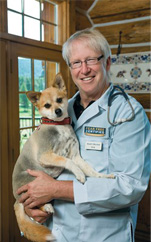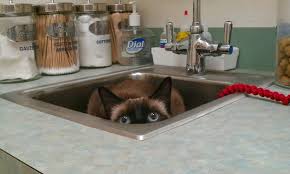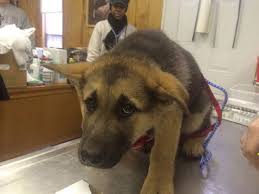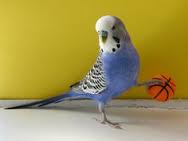Eliminating Fear of Vet Visits
Dr. Marty Becker
 Going to the vet can be a traumatic experience for your pet. Following Animal Radio Veterinary Correspondent Dr. Marty Becker's instructions can make the vet actually a fun place to go. It is called Fear Free Visits.
Going to the vet can be a traumatic experience for your pet. Following Animal Radio Veterinary Correspondent Dr. Marty Becker's instructions can make the vet actually a fun place to go. It is called Fear Free Visits.
We love our animals and we do some crazy things for them. But, there are also some not-so-crazy things we can do for them.
For example, when it comes to vet visits, you need to take the 'pet' out of 'petrified.' So what does this mean? Think about when you're looking at your pet. You can tell when they're calm and happy and relaxed. This can be when they are getting a treat or just sitting quietly by your side. Next, look at the times when they are fearful and stressed. This may happen when they come across an unfamiliar dog on their walk or it may be a trip to a veterinarian.
Most animals know when it's time to go to the vet's. They may see you get the carrier out or they may read your body language, they may even know the route you drive to take them there.
There are a lot of things vets have learned on creating fear-free vet visits that pet owners need to be aware of.
There are certain anxiety and fear triggers that are part of taking your pet to the vet. So if you have a small dog or cat and you're going to use a carrier, don't get it out the night before or the morning of the visit. If you do, you are guaranteed to have a pet that is going to have instant anxiety that lasts throughout the trip and even the actual visit.
The ideal thing to do is to leave the carrier out all of the time. If you hate the idea of leaving one of those plastics crates lying around, there are now many designer carriers that aren't eyesores and can look like cool pet furniture. To make the space desirable for your pet, put new toys in the carrier or even treats. Be sure to let any children know that that is a safe place for their pet and they shouldn't bother them while they are in there.
 If your pet is going in for a wellness visit, you need to prepare a week out. This will involve the use of pheromones. You should get a recommendation from your veterinarian for a brand, as many of them look the same but don't work the same.
If your pet is going in for a wellness visit, you need to prepare a week out. This will involve the use of pheromones. You should get a recommendation from your veterinarian for a brand, as many of them look the same but don't work the same.
These pheromones can be sprayed on a towel or pad in the carrier. You can also spray them in your car just before a vet trip. Your vet clinic should also be using them.
There are also some natural "chill pills," or even pressure garments like ThunderShirt. You need to also start the chill pills about a week prior to a vet visit.
When it actually comes time to take your pet to the vet, don't do it with dread. Put on your "happy voice" and make it sound like it will be fun. You want your pet hungry, so you might think about not feeding them the night before the visit.
Depending upon the weather, you might need to pre-cool or pre-heat the car before you put your pet in it.
When you place your pet in the car in a carrier, place them in the backseat on the floor or the very back if you have a SUV. You should also cover them with sheet or towel to reduce visual stimuli.
 You might even want to go on iTunes and download songs from either Through A Dog's Ear or Through a Cat's Ears, which is calming music specifically for an animal.
You might even want to go on iTunes and download songs from either Through A Dog's Ear or Through a Cat's Ears, which is calming music specifically for an animal.
Next, DON'T baby talk your pet on the drive to the vet.
If you do these things: bring it hungry; start the pheromones and chill pills a week out; play music on the car; don't use baby talk to them; and cover their carrier, you are going to arrive at the vet office with a pet that seems like they've had three glasses of wine and a valium!
Visit Fear Free Happy Homes for tips on making your home fear free and to locate a Fear Free Veterinarian near you. Go to Fear Free Pets to become certified.
Listen and Explore the Fear Free Expert Series
Lily And The Octopus
Steven Rowley
 Steven Rowley tells us about his close relationship with his dog Lily and how a tumor on her head eventually took her life. He's was offered one million dollars to write a cathartic book about the experience on spec. Not bad for his first major published novel!
Steven Rowley tells us about his close relationship with his dog Lily and how a tumor on her head eventually took her life. He's was offered one million dollars to write a cathartic book about the experience on spec. Not bad for his first major published novel!
Lily and the Octopus was Steven Rowley's first book. He explains that he did write the book first, without any offers. However, after his publisher read it, they were quite generous with him. Steven thinks it is amazing and something like a Cinderella story the way it took place.
While his book is very much a novel, he did have a Dachshund named Lily, who he had since she was a puppy until the age of 13 when she succumbed to cancer.
After Lily's passing, he sat down and wrote about his experiences with her, never expecting it to turn into a published novel. He wrote it to help him heal and understand his loss. He tried to be as emotionally true as to what he was feeling and somehow that seems to be resonating with readers.
The octopus in the story is metaphorically a tumor. Lily had a little lump above one of her eyes that started to grow, which lead Steven to think of it is an octopus which had a hold of her. Unfortunately, it was fast growing brain tumor and it was only a couple of months from the time it was diagnosed to the end of her life.
When Steven sat down to write, his goal was to write about attachment and loss. There was something about the metaphor of an octopus, which has tentacles and can have sort of a literal stranglehold on you and how hard it can be to let go when it's time.
While Lily and the Octopus is a book about grief, it is not without humor and celebration of life and our relationships with our pets.
Steven had dogs growing up while living in rural Maine. However, when he grew up in the 70's, relationships at that time with our pets were different from what they are now. Dogs back then were mostly outdoor pets. Lily was the first dog that Steven raised from puppyhood and who also was very much a family member to him.
 Steven now has a new rescued dog named Tilda, who is a terrier mix. When it came time to getting another dog, he had a good home and felt that not providing a home to another dog in need was selfish. He felt was ready to open his house and his heart to a new dog. Tilda had rough beginnings and was shot up pretty badly with a BB Gun. She lost one eye and had several broken ribs so she was also ready for a safe place to live. While she was not quite so ready to trust another person, after a delicate dance between her and Steven, they became good friends.
Steven now has a new rescued dog named Tilda, who is a terrier mix. When it came time to getting another dog, he had a good home and felt that not providing a home to another dog in need was selfish. He felt was ready to open his house and his heart to a new dog. Tilda had rough beginnings and was shot up pretty badly with a BB Gun. She lost one eye and had several broken ribs so she was also ready for a safe place to live. While she was not quite so ready to trust another person, after a delicate dance between her and Steven, they became good friends.
Steven admits that it was hard to get another dog and his biggest fear is that she might be too much like Lily, which he would resent her for, or what if she was not at all like Lily and he had trouble attaching to her. But as Steven admits, each relationship with a dog is unique and provides its own love.
So what would he say to someone who recently lost an animal and is not sure about getting another one? Steven states that people who love animals have a special bravery. These people love their animals fully knowing that they don't live as long as we do, but we love them fully anyway. We lose them, we grieve. Many of us then get to the back of the line and sign up to do it all over again. He says this is a special kind of human being. That is his tribe and the people he love.
Follow Steven Rowley on Twitter and Instagram.
Pet Adoption Tour
Susan Sims, 13th Annual Fido Friendly Get Your Licks On Route 66
 It's time again for the 13th Annual "Get Your Licks on Route 66 Adoption Tour." Fido Friendly publisher Susan Sims started the nationwide journey in Sedona, Arizona and will continue across Route 66 through October stopping at shelters along the way to support adoption events through October. The annual tour has successfully worked with local animal shelters across the country to find forever homes for over 14,000 pets in the last 12 years.
It's time again for the 13th Annual "Get Your Licks on Route 66 Adoption Tour." Fido Friendly publisher Susan Sims started the nationwide journey in Sedona, Arizona and will continue across Route 66 through October stopping at shelters along the way to support adoption events through October. The annual tour has successfully worked with local animal shelters across the country to find forever homes for over 14,000 pets in the last 12 years.
"We are so excited about this year's tour," Founder Susan Sims, Publisher of FIDO Friendly Magazine, said. "After all that we have been through during COVID-19, this tour is going to be special. We can't wait to help participating animal shelters find forever homes for their homeless pets and through our prize wheel, raise money for the individual shelters."
Stop by their events to spin their giant spinning wheel filled with prizes provided by their sponsors, where a donation gives you a chance to win fabulous prizes and all proceeds go to the shelter at the end of the day.
 Thanks to their sponsors who have signed up thus far to help us save lives, one shelter at a time! Please visit their websites to see the great products they have to offer: Zymox, Catit, MyPlaceHotels, Sure Petcare, HomeAgain, Embrace Pet Insurance,Tito's Vodka, Brutus Bone Broth, Dog TV, Buddy Belts, HandsOn Gloves and KOA Campgrounds.
Thanks to their sponsors who have signed up thus far to help us save lives, one shelter at a time! Please visit their websites to see the great products they have to offer: Zymox, Catit, MyPlaceHotels, Sure Petcare, HomeAgain, Embrace Pet Insurance,Tito's Vodka, Brutus Bone Broth, Dog TV, Buddy Belts, HandsOn Gloves and KOA Campgrounds.
Thanks also to the Spinning Wheel Sponsors: Shed Defender, 5Strands Affordable Testing, Bark Potty, CBD Living, John Paul Pet, Licks Pill Free, Suitical, Suzies CBD Treats, Charlee Bear, Pet's Best Life, Petcurean and Bike Tow Leash.
Their remaining tour schedule is as follows:
 Sept. 25: Kansas City Pet Project, Kansas City, MO, Event held noon-4, Kansas City Pet Project, 7077 Elmwood Ave., Kansas City, MO
Sept. 25: Kansas City Pet Project, Kansas City, MO, Event held noon-4, Kansas City Pet Project, 7077 Elmwood Ave., Kansas City, MO
Sept. 30: Springfield, Illinois, Animal Protection League, Event held 11-3, PetSmart, 3183 S. Veterans Pkwy., Springfield, IL
Oct. 2: Chicago Animal Care and Control, Event held noon-4, Chicago Animal Care and Control, 2741 S Western Ave, Chicago, IL
LAST EVENT! Thanks to all of our sponsors who made this trip possible.
Oct. 9: Nebraska Humane Society, Omaha, Nebraska, Event held 11-3, Nebraska Humane Society, 8929 Fort St., Omaha, NE
Please check back often for updates and even in you are not planning on adopting an animal, come out for the fun and spin the wheel for prizes!
http://www.fidofriendly.com
Multiple Cats, Stress & Illness - Dr. Debbie
 Caring for one cat is easy. Adding a second or third doesn't take much more work. But how many cats are too many? As the number of cats in a home increase, there is greater risk of behavior and health disorders - partly due to higher stress. Problem behaviors like hissing, chasing and soiling outside the litter box are more common in multi-cat homes. But environmental stress contributes to medical disorders too. That's right - stress will make your cat sick.
Caring for one cat is easy. Adding a second or third doesn't take much more work. But how many cats are too many? As the number of cats in a home increase, there is greater risk of behavior and health disorders - partly due to higher stress. Problem behaviors like hissing, chasing and soiling outside the litter box are more common in multi-cat homes. But environmental stress contributes to medical disorders too. That's right - stress will make your cat sick.
Defining Feline Stress
Crowding within a home zone creates psychological stress for cats. Cats are social creatures, but don't form social structures like dogs or people. They require room to be away from fellow cats and retreat to their own space. But just having more square footage isn't enough. Cats require a multi-dimensional environment with vertical perching sites and hiding spots.
Household activity, changes in the home and the presence of outdoor cats nearby can rile up your cat's stress level. It's easy for cat owners to fail to detect clues of cat stress in the multi-cat household. A majority of cat communication is nonverbal, so even if you don't hear growling or hissing, your cats can be stressed out.
Even mealtime can be stressful. A study of feral cats has shown that cats hunt and eat their prey preferably away from other cats. Feral cats eat up to 10 to 20 times throughout the daytime and night. So kibble offered to pet cats in a large communal bowl once to two times a day is contrary to innate kitty dining behaviors.
Cat Stress=Sickness
Just as in people, the mind-body connection is at work in cats too. Higher stress results in higher levels of compounds that result in bodily inflammation and suppress immune responses.
Feline interstitial cystitis, also referred to as feline idiopathic cystitis (FIC), is an inflammatory problem of the bladder typified by frequent urinations, straining to urinate, and bloody colored urine. The cause of FIC isn't completely known, but stress is believed to contribute to its development. Cat owners are shocked to learn that those bloody urine accidents may have nothing to do with bacteria, and everything to do with stress.
Other stress related health problems include excess grooming behaviors, obsessive-compulsive behaviors and obesity. Cats in high-density living situations may be prone to upper respiratory outbreaks even if residing solely indoors. Stress and an indoor lifestyle have also been implicated in contributing to obesity, hyperthyroidism, diabetes, and dental disease.
 What to Do
What to Do
It's not that you can't have multiple cats, but you need ensure you can provide the environment for more cats. Consider the feline perspective with living space, feeding, and interaction with other animals and people.
Add cats to the home that share similar personalities. A rowdy cat gets along best with other rowdy cats. A timid cat may be stressed out and fail to thrive in a home where fellow cats are outgoing or rambunctious cats.
Work toward household harmony by following the basic guidelines in resources. Provide ample resources to avoid competition, and therefore stress. Provide one more resource than the number of cats in the home. For two cats you should have three litter boxes and three feeding/watering sites.
Vertical height equals safety to cats, so provide ample perching sites for cats, such as cat trees and window perches. Stick to the rule for one more perching site than kitty in the home. Provide hiding spots like paper bags or cardboard boxes.
Promptly address feline behavior problems when they arise by consulting with your veterinarian or a veterinary behaviorist.
For more information on enriching your indoor cat's environment, visit the Indoor Pet Initiative. This resource is provided by the Ohio State University College of Veterinary Medicine.
Featured veterinarian known as "Dr. Debbie" on national pet radio program, Animal Radio. Ebook author of "Yorkshire Terriers: How to Be Your Dog's Best Friend"; "Pugs: How to Be Your Dog's Best Friend"; "Mini Schnauzers: How to Be Your Dog's Best Friend"; and "Shih Tzu: How to Be Your Dog's Best Friend." Dr. Debbie's books.
Visit Website
5 Reasons Birds Make Incredible Pets
Robert Semrow, Animal Radio Listomania
 It's no secret that birds are intelligent and are increasingly becoming popular as pets and companions. Those who have had the privilege and joy of having a bird as a companion will sing their praises if given a chance. I thought I'd share 5 reasons birds make great pets:
It's no secret that birds are intelligent and are increasingly becoming popular as pets and companions. Those who have had the privilege and joy of having a bird as a companion will sing their praises if given a chance. I thought I'd share 5 reasons birds make great pets:
To begin with, birds are very intelligent. They are able to learn from, bond with and interact with their owners. They are playful and maybe most endearingly can greet you with the actual words like, "Hello Rob, How was your day?" When was the last time your dog or cat spoke to you in actual words, made uncanny remarks at the most perfect time and carried on actual conversation with you? Ok, maybe the conversations are a bit repetitive, but still, how great is it to hear your pet say "I love you!"
Next up is the advantage that they are easy to care for. They require minimal grooming and are naturally very clean and hygienic animals. They take pride in themselves and will preen themselves daily to keep their feathers shiny and clean. They require little space; little food and can get by with a little time when time is short in supply. It is also easier to clean a cage once a day than multiple clean ups for dogs and cats.
 Another advantage is that they do not need much space to live in. While a bird cage with more space is always more desirable, many get by with minimal space. If you are someone who doesn't have a lot of space or a lot of time, a bird may be a perfect pet for you. Bird toys are also another easy thing to provide for them. Birds are able to make almost anything in to an item of interest and play.
Another advantage is that they do not need much space to live in. While a bird cage with more space is always more desirable, many get by with minimal space. If you are someone who doesn't have a lot of space or a lot of time, a bird may be a perfect pet for you. Bird toys are also another easy thing to provide for them. Birds are able to make almost anything in to an item of interest and play.
Next, birds are fairly easy to train. Their intelligence and curiosity make them willing, eager and very capable learners. They do love to interact and please, combining all of this makes them much easier to become well-trained and extremely entertaining members of the family. Remember that birds are beautiful and have different features and habits that will certainly keep you entertained and engaged for a very long time.
Next up is that they also don't eat as much as other pets. They literally eat like birds. In addition to pellets, seed and other prepared bird foods, many birds enjoy appropriate fruits and vegetables. This leads us to the importance of knowing what things can be toxic to them as they and their systems are much smaller and more susceptible.
Finally, most birds stick to a regular schedule that when followed, provides predictability and a healthy environment for you and your bird. So if you are thinking about a bird as a pet, do your research and know that you are possibly making one of the best friends you'll ever have.
Share your pet bird stories on our Animal Radio Facebook Page.
http://petworldinsider.com
Animal Radio News - Lori Brooks
 First Drug To Treat Canine Noise Anxiety>
First Drug To Treat Canine Noise Anxiety>
Fourth of July and all of its noise is gone for this year, but the next biggest noise-making holiday will be New Year's Eve. Hopefully it will be better for the many dogs that are noise sensitive and petrified of all the sounds. But of course there's thunder too, which can happen at any time. It is entirely possible that no one dreads the dog days of summer more than dogs themselves. By some estimates, at least 40-percent of dogs experience noise anxiety. Any vet can tell you about dogs who took refuge in hiding places so tight that they got stuck, who gnawed on door handles, chewed through walls or fences, crashed through windows or raced into traffic. Animal behavior experts who have studied such dogs say, "It's a very serious panic disorder with a complete flight response." Over the years, a variety of remedies for noise anxiety have sprung up such as homeopathic blends, pheromones, CDs of thunderstorms mixed with music, special shirts or jackets, even Prozac and Valium. Fortunately the FDA approved the first drug to treat canine noise aversion. It's called Sileo. It inhibits nor-epinephrine, a brain chemical associated with anxiety and fear responses. The new drug is actually a micro-amount of a medication approved as a sedative for minor veterinary procedures. It is a flavorless gel measured in a syringe, which is squeezed between the dog's cheek and gum and absorbed within 30 minutes. It was tested on several hundred noise-averse dogs during two years of New Year's fireworks. Seventy-Five percent of the owners rated the dogs' response as good to excellent. The drug lasts several hours, after which another dose can be administered. A syringe costs about $30 and holds several weight-dependent doses. Sileo's main side effect, in about 4 to 5 percent of the dogs, was vomiting. The optimal solution, as Dr. Debbie has said before, is catching the response early and de-sensitizing the dog with calibrated recordings of the offending noise and positive conditioning. By the way, cats can have noise aversion, though reports are less common.
 Internet Outage Causes Starving Pets
Internet Outage Causes Starving Pets
The Internet of Things may be touted as the next big thing in technology, but those Internet connected solutions designed to make your life easier can cause huge problems as many pet owners have found out. PetNet, an internet-connected feeding service, has experienced a server outage that left many pets hungry for hours and many pet owners very upset! The $149 PetNet system is marketed as, "The world's first intelligent pet feeder that will program itself around your life and the wellness of your pet." The smart feeder manages food supply, timing and even portion size. But because of the server outage, hundreds of pets were not fed. The company put out an email explaining the problem and said, "Please ensure that your pets have been fed manually until we have resolved this issue." Many PetNet users were miffed because apparently they had not realized that the device, which relies on the system's central server to manage and schedule the smart feeders, does not have a backup system to deal with such emergencies. While most were outraged about the outage, some users took it in stride like one guy who posted that he had just manually fed his dog, by pouring kibble in a bowl and setting the bowl on the floor.
 Salmonella Outbreak from Backyard Chickens and Ducks
Salmonella Outbreak from Backyard Chickens and Ducks
Many people have gotten sick with outbreaks of salmonella, which has been traced to pet chickens or ducks, kept in backyard flocks. Health officials are warning that as tempting as it might be to nuzzle up to a fluffy chick, owners of poultry pets should rein in the affection to protect themselves from illness. Forty-five states have reported outbreaks of salmonella linked to live poultry in backyard flocks, so it's pretty serious. If you have kids, make sure they are especially careful as one third of infections have been in children under 5 years old. Remember, all live poultry can carry salmonella bacteria, even if they look healthy and clean. Coming in contact with bird droppings can also infect people. But there are steps you can take to avoid illness:
· Don't kiss chickens and ducks or bring them close to the face
· Always wash hands well with soap and water after handling feathered pets
· Don't let live poultry inside the house
· Don't let kids under 5 handle or touch chicks, ducklings, or other live poultry without adult supervision
 Demise of the Bulldog?
Demise of the Bulldog?
There's a study out on what could be the demise of bulldogs. The English Bulldog is one of the most popular breeds in the world because of its child-like appearance and behavior. But the alterations in body type and behavior needed to create the breed we're used to seeing has required many physical changes, way beyond its village dog ancestors of years ago. These changes have occurred over hundreds of years, but have sped up significantly over the last decades. Unfortunately, popularity does not equate to health and there have been increasing pressures on breeders to moderate the extreme physical changes that now affect the breed and its health. However, improving health by breeding in changes that would positively impact the health of bulldogs may no longer be possible. Research shows there is likely not enough diversity in the genes to improve the breed from within, so they should seek to improve the breed by out-crossing to other breeds. The results confirm that the breed has lost considerable genetic diversity from highly focused selection for specific desired physical traits like big heads and loose skin.
 Thieves Unknowingly Save Dog From Hot Car
Thieves Unknowingly Save Dog From Hot Car
An unlikely Good Samaritan, who happened to be a smash and grab thief, saved a German Shepherd in the Chicago area from certain death. But it's a good thing in this case. It all began when a man left his laptop and his dog, the German Shepherd, locked in his pick-up truck while he went into a local pub. It was super hot that day, but luckily for the dog, a pack of thieves were casing the street for easy to grab loot and spotted the laptop sitting on the truck's passenger seat. They smashed the window, grabbed the laptop and ran off. When the man came out and saw his window and laptop gone he told authorities he maybe left the vehicle for 15 to 20 minutes. The bar owner pulled her security camera video and learned the dog would have been in the truck for an hour with an approximate temperature of 120. The bar owner said she would have smashed the window out herself, but she would have done it to get the dog out.
 Listen to the entire Podcast of this show (#1138)
Listen to the entire Podcast of this show (#1138)





